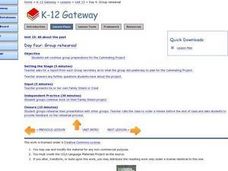Curated OER
Europe Maps
A series of maps depicts pre-WWI to post-WWII Europe for your geographers. They use reference materials to help them correctly fill in the countries and the borders as they changed through time. A great resource for a history lesson, or...
Curated OER
Denmark
Students create a nature journal for an imaginary trip around Denmark. They identify animals and plants that live in Denmark. Students describe the landscape of Denmark. They summarize and present historical information about an assigned...
Curated OER
Family Album
Kids of all ages discover their family histories through pictures. First, flip through the PowerPoint provided (or consider making one of your own). It should show pictures of your family and have clear, easy to understand sentences that...
Urbana School District
Magnetism
The compass was first used in 206 B.C., but we didn't discover magnetic poles until 1263 A.D. Presentation begins with the history of magnetism before continuing on to magnetic fields, magnetic forces, electromagnets, currents,...
Edline
How Did the Unification of Germany Change the Course of World History?
Here you'll find a nice guided notes worksheet on Otto von Bismarck, which details Bismarck's plan to unify Germany, as well as asks learners to analyze his motivations and overall impact.
Curated OER
The Holocaust: An Introduction for Children (To Be Used with Number the Stars)
In this literature and history worksheet, students prepare to read the novel by Lois Lowry Number the Stars. Students read the history behind the Nazi occupation of Denmark and the arrest of the Jews there. This is a 10 page historical...
TED-Ed
Tycho Brahe, the Scandalous Astronomer
Who says scientists are boring geeks? Certainly not the narrator of a short video who dishes up the scandals associated with Tycho Brahe, a Danish scientist and alchemist (now that's two labels you don't often see together) who used...
Curated OER
Communicating with My World
Learners create a time capsule. In this oral presentation and history preservation lesson, students provide feedback for their time capsule project, work with a partner to write an oral presentation, and present their time capsule to the...
Curated OER
Group Rehearsal
Students study their national and family heritage while working in groups. In this personal history project, students examine the family shield or crest of the teacher while preparing to create and share their own with the class....
Curated OER
Number the Stars, by Lois Lowry. New York: Dell 1990
Students recognize courage and heroism of Danish and Swedish people and all others who resisted the Nazis, realize that everyone has the capacity to do good as well as evil, and analyze reasons and motivations that caused certain people...
Curated OER
A Picture Speaks A Thousand Words
Students explore the power of images through political cartoons, particularly in light of the Danish caricatures of Muhammad that have incited violence around the world. They create their own original artwork to submit to an appropriate...
Google
Google Translate
Not sure how to translate a word, phrase, or paragraph? No worries. Simply paste in, type, or dictate your text, select the initial and desired language, and up pops your translation. Better yet, the app will read the text to you in most...
Curated OER
Number the Stars
In this Language Arts instructional activity, students read an introduction to the novel Number the Stars. Students read about the how the author, Lois Lowry, researched about the Danish Resistance.
Curated OER
Number the Stars The Holocaust
In this social studies learning exercise, students read a brief history of the Holocaust and its connection to Number the Stars. Students read about when Hitler came to power, concentration camps, and people who helped rescue Jews.
Curated OER
Number the Stars Historical Background: Kim Malthe-Bruun
In this history and literature worksheet, students read a true biography of a Danish resistance fighter named Kim Malthe-Bruun. In the novel Number the Stars, the character of Peter is based on this young man. There are no questions to...
Curated OER
Night: Annotated Bibliography
This annotated bibliography and list of websites are valuable resources for any study of the Holocaust and/or of Elie Wiesel's Night.
Curated OER
Ages in Stages: An Exploration of the Life Cycle based on Erik Erikson's Eight Stages of Human Development
Examine Erikson's chart on the various stages one goes through growing up. Individually, they write a paper on whether or not they fit into those categories and how they are different today. In groups, for each stage they role play the...
US Institute of Peace
Governance, Corruption and Conflict Simulation on Nepal
Can your class help the people of Nepal? Scholars take an in-depth look into the social injustices and struggling economy of a country in turmoil during a multi-day role-playing exercise. After reviewing information on the problems...
Curated OER
Countries and Languages Quiz
In this online interactive geography quiz activity, students examine the chart that includes 20 languages. Students identify the names of the countries with the greatest number of native speakers in 4 minutes.
Curated OER
Reading Retake Practice: Lego
In this activity about an article from The New Yorker magazine titled, "Lego" students read the article and then answer 7 comprehension questions.





















